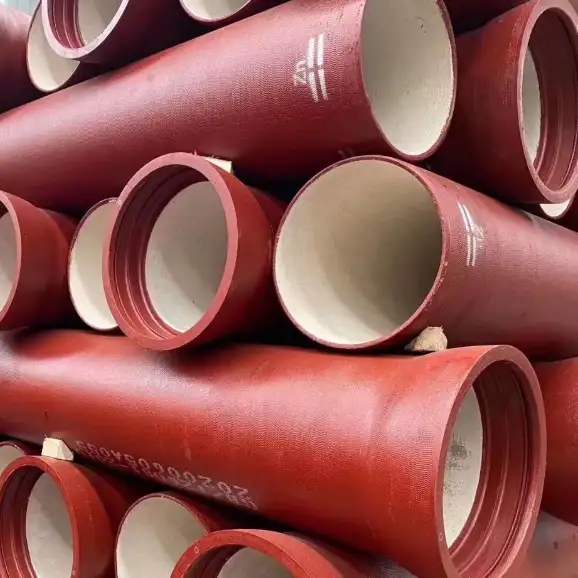Ductile iron, also known as nodular cast iron, is a high-performance engineered material renowned for its exceptional strength, flexibility, and durability. Combining the castability of traditional iron with enhanced mechanical properties—thanks to its unique spheroidal graphite microstructure—ductile iron is widely used in water infrastructure, automotive components, and industrial machinery.

1. Introduction to Ductile Iron
Ductile iron, also known as nodular cast iron or spheroidal graphite iron (SGI), is a type of cast iron characterized by its unique microstructure. Unlike traditional gray cast iron, which contains flake-like graphite, ductile iron features spherical graphite nodules. This alteration significantly enhances its mechanical properties, making it a preferred material in various industrial applications.
2. Microstructure and Composition
The microstructure of ductile iron is primarily composed of a matrix of ferrite, pearlite, or martensite, with spherical graphite nodules dispersed throughout. The formation of these nodules is achieved by adding small amounts of nodulizing elements such as cerium, magnesium, or rare earth metals during the casting process.
Chemical Composition:
| Element | Typical Range (%) |
|---|---|
| Carbon (C) | 3.0 – 4.0 |
| Silicon (Si) | 2.0 – 3.0 |
| Manganese (Mn) | 0.1 – 0.5 |
| Phosphorus (P) | ≤ 0.1 |
| Sulfur (S) | ≤ 0.02 |
| Magnesium (Mg) | 0.03 – 0.05 |
This composition results in a material that combines the castability of gray iron with the strength and ductility of steel.
3. Mechanical Properties
Ductile iron exhibits a combination of high strength, excellent ductility, and good wear resistance. Its mechanical properties can be tailored by adjusting the matrix structure and alloying elements.
Typical Mechanical Properties:
| Property | Value |
|---|---|
| Tensile Strength | 400 – 1200 MPa |
| Yield Strength | 250 – 800 MPa |
| Elongation | 2% – 18% |
| Hardness (Brinell) | 150 – 300 HB |
| Impact Toughness | High |
These properties make ductile iron suitable for applications requiring high strength and impact resistance.
4. Types and Grades of Ductile Iron
Ductile iron is classified into several grades based on the matrix structure and mechanical properties. The most common grading system is ASTM A536, which defines grades by their tensile strength, yield strength, and elongation.
Common Grades:
-
Grade 60-40-18: Tensile Strength: 60 ksi (414 MPa), Yield Strength: 40 ksi (276 MPa), Elongation: 18%
-
Grade 80-55-06: Tensile Strength: 80 ksi (552 MPa), Yield Strength: 55 ksi (379 MPa), Elongation: 6%
-
Grade 100-70-03: Tensile Strength: 100 ksi (690 MPa), Yield Strength: 70 ksi (483 MPa), Elongation: 3%
These grades allow engineers to select the appropriate material based on the specific requirements of the application.
5. Manufacturing Processes
The production of ductile iron involves several key steps:
-
Melting: The base iron is melted in a furnace.
-
Nodulizing: Magnesium is added to the molten iron to promote the formation of spherical graphite nodules.
-
Pouring: The molten iron is poured into molds to form the desired shape.
-
Cooling: The castings are allowed to cool and solidify.
-
Heat Treatment: Depending on the desired properties, the castings may undergo heat treatment processes such as annealing or austempering.
These processes ensure the production of ductile iron with consistent quality and desired mechanical properties.
6. Applications of Ductile Iron
Ductile iron’s combination of strength, ductility, and castability makes it suitable for a wide range of applications:
-
Automotive Industry: Engine components, crankshafts, camshafts, and suspension parts.
-
Piping Systems: Water and wastewater pipes, fittings, and valves.
-
Agricultural Equipment: Housings, hubs, and frames for machinery.
-
Industrial Machinery: Gearboxes, pumps, and frames.
-
Wind Power: Hubs and structural components for turbines.
These applications leverage ductile iron’s ability to withstand high stress and impact loads.
7. Advantages and Limitations
Advantages:
-
High Strength and Ductility: Suitable for components subjected to dynamic loads.
-
Excellent Castability: Allows for complex shapes and reduced machining.
-
Cost-Effective: Lower material and processing costs compared to steel.
-
Good Wear Resistance: Ideal for components exposed to abrasive conditions.
Limitations:
-
Sensitivity to Magnesium Variations: Inconsistent nodulization can affect properties.
-
Susceptibility to Graphitization: High temperatures can lead to graphite formation, reducing strength.
-
Limited by Alloying Elements: Certain alloying elements can negatively impact properties.
8. Comparison with Other Cast Irons
| Property | Ductile Iron | Gray Iron | White Iron |
|---|---|---|---|
| Graphite Form | Spherical | Flake | None |
| Tensile Strength | High | Moderate | Very High |
| Ductility | High | Low | Very Low |
| Wear Resistance | Good | Poor | Excellent |
| Castability | Excellent | Excellent | Poor |
Ductile iron offers a balance between strength, ductility, and castability, making it versatile for various applications.
9. Future Trends and Innovations
Advancements in ductile iron technology include:
-
Enhanced Alloying: Development of new alloy compositions to improve properties.
-
Advanced Casting Techniques: Use of 3D printing and other technologies to produce complex shapes.
-
Sustainability Initiatives: Recycling and energy-efficient production methods.
These innovations aim to expand the applications and performance of ductile iron.
10. Frequently Asked Questions (FAQs)
1. What is ductile iron?
Ductile iron is a type of cast iron characterized by its spherical graphite nodules, which provide enhanced strength and ductility compared to traditional gray cast iron.
2. How is ductile iron produced?
Ductile iron is produced by adding magnesium to molten iron to promote the formation of spherical graphite nodules, followed by casting and heat treatment processes.
3. What are the main applications of ductile iron?
Ductile iron is used in automotive components, piping systems, agricultural equipment, industrial machinery, and wind power applications due to its strength and ductility.
4. How does ductile iron compare to other cast irons?
Ductile iron offers higher strength and ductility than gray iron and better wear resistance than white iron, making it suitable for a wider range of applications.
